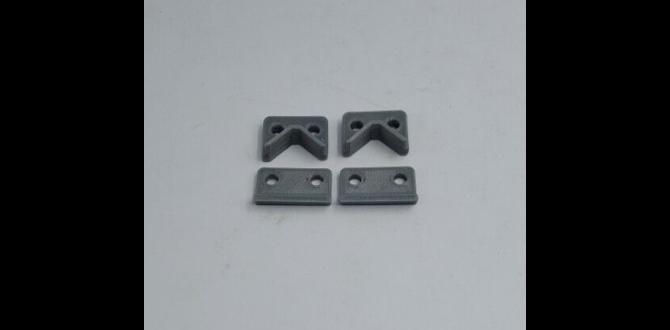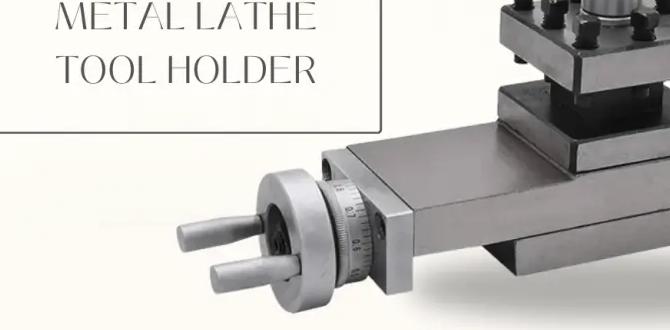Carbide end mills are your secret weapon for conquering chatter when machining cast iron, giving you smoother finishes and longer tool life.
Ever heard that annoying, chattering sound when milling cast iron? It’s a common frustration for many machinists, making it tough to get a clean cut. This vibration can lead to rough surfaces, premature tool wear, and even damage to your workpiece. But don’t let it get you down! With the right approach and the right tools, you can say goodbye to chatter and hello to smooth, precise machining. In this guide, we’ll explore why carbide end mills are so effective at taming this beast and how to use them to get the best results. We’ll break down everything you need to know, step-by-step, so you can tackle cast iron with confidence.
Understanding Cast Iron and the Chatter Challenge
Cast iron, with its high carbon content, offers excellent wear resistance and vibration damping properties, making it a popular choice for machine bases, engine blocks, and many other engineering components. However, these very characteristics can make it tricky to machine. The graphite flakes within cast iron can create inconsistencies in the material’s structure, leading to varying cutting resistance.
When a cutting tool encounters these variations, it can start to vibrate. This vibration, known as chatter, is a sympathetic resonance between the cutting tool, the workpiece, the machine spindle, and even the machine structure itself. It’s a vicious cycle: the tool vibrates, hitting the material unevenly, which causes more vibration. This results in:
- Rough surface finishes that are difficult to clean up.
- Increased tool wear and potential for rapid tool breakage.
- Reduced accuracy and dimensional stability of your part.
- Unpleasant noise and a general feeling of being out of control.
Several factors contribute to chatter, including:
- Machine Rigidity: A less rigid machine or setup will amplify vibrations.
- Tool Geometry: The shape and cutting angles of your end mill play a huge role.
- Cutting Parameters: Speed, feed rate, and depth of cut all influence cutting forces.
- Tool Condition: A dull or damaged tool is more prone to chatter.
- Workpiece Rigidity: How well the part is clamped and supported.
While improving machine rigidity and optimizing cutting parameters are crucial, the cutting tool itself is often the first line of defense. This is where carbide end mills shine.
Why Carbide End Mills are Your Go-To for Cast Iron Chatter Reduction
Carbide, specifically tungsten carbide, is a super-hard, dense material that offers significant advantages over traditional High-Speed Steel (HSS) for machining tough materials like cast iron. Its properties make it incredibly effective at resisting the forces and vibrations that cause chatter.
Superior Hardness and Rigidity
Carbide is significantly harder and more rigid than HSS. This means it can maintain its cutting edge longer and resist deformation under heavy cutting loads. A stiffer tool is less likely to deflect and vibrate, directly combating the root cause of chatter.
Higher Heat Resistance
Machining cast iron generates considerable heat. Carbide’s ability to withstand higher temperatures allows it to maintain its hardness and cutting performance even in hot cutting zones, preventing premature dulling which often exacerbates chatter.
Better Surface Finish Potential
The inherent stiffness and edge retention of carbide tools allow for more consistent contact with the workpiece. This leads to cleaner cuts and a smoother surface finish, which is the direct opposite of the rough, damaged surface caused by chatter.
Longer Tool Life
Because carbide is harder and more heat-resistant, it typically lasts much longer than HSS tools when machining abrasive materials like cast iron. This translates to fewer tool changes, lower overall tooling costs, and more consistent results over time.
Choosing the Right Carbide End Mill for Cast Iron
Not all carbide end mills are created equal, especially when machining difficult materials like cast iron. To maximize chatter reduction and achieve optimal results, consider these key features:
1. Material: Carbide (Tungsten Carbide)
This is the fundamental choice. Ensure the end mill is explicitly labeled as carbide. For cast iron, general-purpose carbide grades are usually sufficient, but for very hard or abrasive irons, you might look for tougher carbide grades. You can learn more about different carbide grades from manufacturers like Sandvik Coromant, a global leader in metal cutting.
2. Flute Design: Specialized for Cast Iron
Flute count, helix angle, and flute finish all impact how well an end mill cuts and evacuates chips. For cast iron, consider:
- Lower Flute Count (2 or 3 flutes): Generally better for cast iron. Fewer flutes provide stronger cutting edges and better chip evacuation in a material that tends to produce abrasive dust. More flutes can lead to clogging and increased chatter.
- Moderate Helix Angle (15-30 degrees): A moderate helix angle offers a good balance between cutting action, chip thinning, and tool strength. Very high helix angles can be too aggressive and chatter-prone, while zero or low helix angles can create excessive cutting forces.
- Polished or Special Coatings: While not always strictly necessary, a polished flute finish helps with chip evacuation and reduces friction. Some specialized PVD coatings can further enhance lubricity and wear resistance for cast iron.
3. End Type: Square, Ball, or Corner Radius
- Square End Mills: Ideal for creating sharp internal corners, slots, and pockets. They are common all-around tools.
- Ball End Mills: Produce a rounded profile, great for 3D contouring and profiling.
- Corner Radius End Mills: These have a small radius at the cutting corners. This is crucial for cast iron chatter reduction because the radius “breaks” the corner, taking a smaller, more controlled bite into the material and reducing the tendency to chatter at the point of engagement. Even a small radius (e.g., 0.010″ or 0.25mm) can make a significant difference.
4. Shank and Reach: Stability Matters
For chatter reduction, rigidity is key. This means:
- Sturdy Shank: A solid shank without a side-lock flat (unless your tool holder absolutely requires it) is generally more rigid.
- Shorter Reach: Unless your operation demands it, opt for an end mill with the shortest possible reach (length of cut). Long, slender end mills are much more prone to vibration and chatter due to their flexibility. A common requirement might be a 1/8 inch 6mm shank long reach, but understanding when to use and when to avoid long reach is important. For minimizing chatter, a standard or shorter reach is often preferred if depth of cut allows.
- For the specific keyword “carbide end mill 1/8 inch 6mm shank long reach for cast iron reduce chatter”: When dealing with limited depth requirements or delicate operations, a 1/8 inch (approx. 3mm) or 6mm shank offers a good balance of tool size and rigidity for smaller workpieces or machines. The “long reach” aspect is more about the flute length extending beyond the shank. Use long reach only when absolutely necessary and employ conservative cutting parameters.
5. Micro-Grain Carbide
Many modern carbide tools are made from micro-grain carbide. This is a finer grain structure than standard carbide, resulting in increased toughness and edge strength, which is beneficial for chatter resistance in tougher materials.
Optimizing Cutting Parameters for Chatter-Free Milling
Even with the perfect carbide end mill, incorrect cutting parameters can still lead to chatter. Here’s how to dial them in:
1. Spindle Speed (RPM)
Finding the sweet spot for spindle speed is critical. There isn’t a single magic number, as it depends on your machine, tool diameter, and material. Start with the manufacturer’s recommended surface speed (SFM or m/min) for cast iron and your tool diameter, and convert it to RPM:
RPM = (SFM × 3.25) / Diameter (inches)
or
RPM = (SCM × 1000) / (π × Diameter (mm)) where SCM is Surface Speed in m/min
Experiment around this initial value. If you hear chatter, slightly increasing or decreasing the RPM in small increments can often find a speed that avoids resonance. Sometimes, a slightly higher RPM can “outrun” the vibration.
2. Feed Rate
Feed rate is the distance the tool travels per tooth per revolution. It’s sometimes referred to as chipload. Cast iron generally requires a moderate chipload. Too light a chipload can cause rubbing and chatter, while too heavy can overload the tool.
For end milling, chipload (in/tooth or mm/tooth) is calculated as:
Chipload = (Feed Rate (IPM or mm/min)) / (RPM × Number of Flutes)
A good starting point for carbide end mills in cast iron is often:
- 0.002″ – 0.006″ per tooth (0.05mm – 0.15mm per tooth) for smaller diameter tools (up to 1/2″ or 12mm).
- Larger tools can often handle higher chiploads.
Crucially, a stable, consistent feed rate is essential. Avoid “air cutting” or rapid, jerky movements. Ensure your CNC program or manual feed is smooth.
3. Depth of Cut (DOC) and Width of Cut (WOC)
These parameters have a massive impact on cutting forces and rigidity. For chatter reduction:
- Conservative Depth of Cut: Start with a shallow depth of cut. For milling in cast iron, taking a depth of cut that is significantly less than the tool diameter can dramatically reduce chatter. Often, 1/4 to 1/2 the tool diameter is a good starting point.
- Conservative Width of Cut: For full slotting, the width of cut is equal to the tool diameter. If you are profiling or pocketing, using a smaller width of cut (e.g., 25-50% of the tool diameter) significantly reduces the radial cutting forces, lessening the chance of chatter. Techniques like chipbreaker milling or full slotting with a smaller stepover can help manage these forces.
- Climb Milling vs. Conventional Milling: Climb milling (where the cutter rotation direction is the same as the feed direction) often results in a lighter cut and can be more effective at reducing chatter in cast iron than conventional milling.
4. Coolant/Lubrication
While some machinists prefer dry machining for cast iron to keep chips cleaner for inspection, using a coolant or lubricant can significantly help. Flood coolant, mist coolant, or even a good quality cutting fluid can:
- Reduce friction and heat, extending tool life.
- Help evacuate chips from the cutting zone, preventing buildup that can cause chatter.
- Improve the surface finish.
For cast iron, a light, non-emulsifying oil or a specific cast iron cutting fluid can be ideal.
Tool Holder and Workholding Rigidity
Your end mill is only as rigid as the system holding it. Even the best carbide end mill will chatter if it’s mounted in a wobbly tool holder or if the workpiece is not securely held.
Tool Holder Considerations:
- Collet Chucks: High-quality collet chucks (e.g., ER collets, though specialized milling chucks are better) provide excellent runout accuracy and a firm grip on the tool shank, minimizing vibration.
- Hydraulic or Shrink Fit Holders: These offer the highest level of rigidity and accuracy, providing a solid interface between the spindle and the tool.
- Avoid Set Screws/Side-Lock Holders: When possible, avoid tool holders that rely on set screws for retention, as they can introduce runout and are less rigid. If you use them, ensure they are properly seated and tightened.
- Cleanliness: Keep tool holders and collets clean. Debris can cause runout and imbalance.
Workholding Considerations:
- Secure Clamping: Ensure your workpiece is clamped firmly and directly onto the machine table or fixture. If it can move or vibrate, it will transmit those vibrations to the cutting tool.
- Support: Use parallels or supports where needed to keep the workpiece from flexing or lifting.
- Reduce Overhang: If possible, machine the part with the shortest possible reach into the casting.
Step-by-Step Process for Reducing Cast Iron Chatter with a Carbide End Mill
Let’s put it all together into a practical guide.
Step 1: Select the Right Carbide End Mill
For our example, let’s assume we are using a:
- Type: Carbide End Mill
- Diameter: 1/4 inch (6mm)
- Number of Flutes: 3
- Helix Angle: 30 degrees
- End Type: Corner Radius (e.g., 0.020″ or 0.5mm radius)
- Reach: Standard (not excessive length)
- Coating: Uncoated or a basic TiN coating for cast iron.
This selection prioritizes edge strength, reduced vibration, and better chip flow for cast iron.
Step 2: Inspect and Mount the Tool
- Visually inspect the end mill for any signs of wear, chipping, or damage.
- Ensure your tool holder (e.g., a good collet chuck) is clean and free of debris.
- Insert the end mill into the tool holder, ensuring it’s seated correctly and the correct projection is achieved (minimize overhang).
- Tighten the tool holder according to its specifications.
Step 3: Program or Set Initial Cutting Parameters
Let’s assume we are working with a modern CNC mill, but these principles also apply to manual milling with adjustments.
- Material: Cast Iron (e.g., Gray Cast Iron)
- Target Surface Speed (SFM): 250 SFM (approx. 75 m/min)
- Tool Diameter: 0.250 inches (6mm)
- Number of Flutes: 3
Calculate Initial RPM:
RPM = (250 SFM × 3.25) / 0.250 inches = 3250 RPM
Set Initial Chipload:
Target Chipload = 0.004 inches/tooth
Required Feed Rate (IPM) = RPM × Number of Flutes × Chipload
IPM = 3250 RPM × 3 flutes × 0.004 inches/tooth = 39 IPM (approx. 1000 mm/min)
Set Depths:
- Depth of Cut (DOC): Start conservatively. For a 1/4″ tool, try 0.050″ (1.25mm). This is 20% of the tool diameter.
- Width of Cut (WOC): For slotting, it’ll be 0.250″ (6mm). For pocketing, try 0.125″ (3mm) (50% of diameter).
Step 4: Perform a Test Cut
If on a CNC, run the program through an air cut first to ensure motion and tool clearance. Then, perform a shallow test cut on the actual part.
Listen carefully for any chatter. Observe the chip formation – they should be small, distinct chips, not a fine powder or long, stringy curls.
Step 5: Adjust and Refine Parameters
This is where the “art” of machining comes in. Based on your observations:
- If Chatter is Present:
- Reduce DOC/WOC: Try an even shallower depth or width of cut.
- Adjust RPM: Increase or decrease RPM in small increments (e.g., 5-10%). Listen for the resonance to disappear.
- Adjust Feed Rate: You can slightly increase the feed rate if the DOC/WOC is already very conservative, but this is less common for chatter than RPM or DOC adjustments.
- Check Tool Holder Rigidity: Ensure everything is tight and seated correctly.
- If Surface Finish is Rough (even without loud






